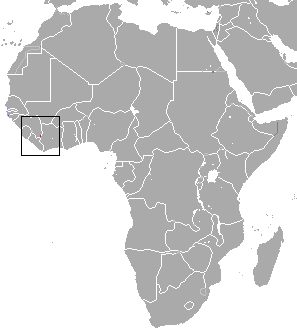Lamotte's roundleaf bat facts for kids
Quick facts for kids Lamotte's roundleaf bat |
|
|---|---|
| Conservation status | |
| Scientific classification | |
| Genus: |
Hipposideros
|
| Species: |
lamottei
|
 |
|
| Lamotte's Roundleaf Bat range | |
The Lamotte's roundleaf bat (Hipposideros lamottei) is a special kind of bat. You can only find it in one place: Mount Nimba. This mountain is right on the border where three countries meet: Côte d'Ivoire, Guinea, and Liberia. Sadly, this bat is in great danger of disappearing forever.
Contents
About Its Name and Family
This bat was first described as a new species in 1984 by a French scientist named André Brosset. He named it lamottei to honor another French scientist, Dr. Maxime Lamotte.
For a while, some scientists wondered if it was truly a different species or just a type of Noack's roundleaf bat. However, a study in 2013 looked closely at its body shape and found that it is indeed a unique species.
Lamotte's roundleaf bat belongs to a group of bats called the caffer/ruber species complex. Think of a species complex like a close-knit family of species that are very similar. Other bats in this family include:
- Sundevall's roundleaf bat, H. caffer
- Noack's roundleaf bat, H. ruber
- H. tephrus
Scientists believe that Lamotte's roundleaf bat became separate from Noack's roundleaf bat not too long ago. It then learned to live specifically in high-altitude areas.
What It Looks Like
This bat is quite small and has a special nose-leaf on its face. This nose-leaf has four tiny flaps, two on each side. Its fur is soft, thick, and brown. Its ears are not very long. The skin on its wings, called patagia, is dark brownish-black.
To give you an idea of its size:
- Its forearm is about 56.1 mm (2.21 in) long.
- Its back foot is about 9.3 mm (0.37 in) long.
- Its tail is between 34.6 and 38.7 mm (1.36 and 1.52 in) long.
Many bats in the Hipposideros group look alike. But you can tell Lamotte's roundleaf bat apart because its forearm is longer than 55 mm (2.2 in), it has a wide head, and its chewing teeth (molars) are small and delicate.
This bat finds its food using animal echolocation. This means it sends out very high-pitched sounds, usually around 119 kHz, and listens for the echoes to create a picture of its surroundings.
Life Cycle and Habits
During the day, Lamotte's roundleaf bats like to rest, or "roost," in caves or old mine shafts. They sometimes share these roosts with other bat species, like the Noack's roundleaf bat and the Angolan rousette.
Because of their small teeth and thin skulls, scientists think these bats probably eat soft-bodied insects.
Scientists once checked a small group of these bats in December. They didn't find any baby bats or pregnant females. This tells us that these bats probably have their babies at a different time of year. Not much else is known about how they reproduce.
Where It Lives
As we mentioned, Lamotte's roundleaf bat has only been found on Mount Nimba. This mountain range is amazing because it has so many different kinds of bats – possibly more than anywhere else in Africa!
Even though the mountain is on the border of three countries, this bat has only been found on the side that belongs to Guinea. It has been seen in two main areas on Mount Nimba:
- A low-lying tropical rainforest
- A higher-altitude afromontane savanna
These bats have been found at heights between 500 and 1,400 m (1,600 and 4,600 ft) above sea level. Most of the places where they roost, like old mine tunnels, are very high up, over 1,200 m (3,900 ft). This suggests they prefer the cooler, higher-altitude savanna and only visit the lowland rainforests sometimes.
Protecting This Bat
The IUCN has listed Lamotte's roundleaf bat as critically endangered. This means it's very close to extinction. It's in such danger because:
- It lives in a very small area, likely less than 100 km2 (39 sq mi).
- The actual space it occupies is even smaller, probably less than 10 km2 (3.9 sq mi).
- All the bats live in just one location.
- Scientists believe their numbers are going down.
The IUCN first looked at this bat in 1996, but they didn't have enough information then. Since 2004, it has been listed as critically endangered.
The biggest dangers to this bat are:
- Mining: People dig for iron ore, which can disturb or destroy the caves and mine shafts where these bats live. In 2013, there were worries that mining would start in the only places where these bats exist, putting them in immediate danger.
- Habitat destruction: Forests are being cut down (deforestation), which destroys the places where the bats live and find food.
- Hunting: In this region, bats are sometimes hunted for food, so this bat might also be caught for bushmeat.
Some of the bat's home is inside the Mount Nimba Strict Nature Reserve. This reserve helps protect the bats, but sometimes the rules aren't followed strictly. Because it's in such serious trouble, the Alliance for Zero Extinction has named it a species facing immediate extinction. In 2013, Bat Conservation International put this bat on its list of 35 top priority species for conservation around the world.


